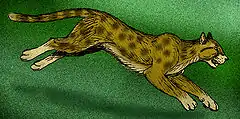American cheetah
The American cheetah is either of two feline species of the extinct genus Miracinonyx, endemic to North America during the Pleistocene epoch (2.6 million to 12,000 years ago) and morphologically similar to the modern cheetah (Acinonyx jubatus).[1] These cats were originally known from fragments of skeletons, but nearly complete skeletons have been recovered from Natural Trap Cave in northern Wyoming.[2]
| American cheetah | |
|---|---|
 | |
| Artist's rendition of M. inexpectatus | |
| Scientific classification | |
| Kingdom: | Animalia |
| Phylum: | Chordata |
| Class: | Mammalia |
| Order: | Carnivora |
| Suborder: | Feliformia |
| Family: | Felidae |
| Subfamily: | Felinae |
| Genus: | †Miracinonyx Adams (1979) |
| Species | |
| |
The two species commonly identified are M. inexpectatus and M. trumani. Sometimes, a third species, M. studeri, is included, but it is more often listed as a junior synonym of M. trumani. Both species are similar to the modern cheetah, with faces shortened and nasal cavities expanded for increased oxygen capacity, and legs proportioned for swift running. However, these similarities may not be inherited from a common ancestor, but may instead result from either parallel or convergent evolution. These were larger than a modern cheetah and similar in size to a modern northern cougar. Body mass was typically around 70 kg (150 lb), with a head-and-body length of 170 cm (67 in), tail length around 92 cm (36 in), and shoulder height of 85 cm (33 in).[3] Large specimens could have weighed more than 95 kg (209 lb).[4]
Taxonomy and evolution
Research into the American cheetah has been contradictory. It was originally believed to be an early cougar representative, before being reclassified in the 1970s as a close relative of the cheetah.[5] This suggested that the ancestors of the cheetah diverged from the Puma lineage in the Americas and migrated back to the Old World, a claim repeated as recently as 2006 by Johnson et al.,[6] and in 2015 by Dobrynin et al.[7] However, other research by Barnett and Faurby, through examining mitochondrial DNA and reanalyzing morphology, has suggested reversing the reclassification: the American cheetah developed cheetah-like characteristics through parallel evolution, but it is most closely related to Puma and not to the modern cheetah of Africa and Asia.[8][9] Moreover, Faurby notes that no Acinonyx fossils have been found in North America, and no Miracinonyx fossils elsewhere. However, O'Brien et al. (2016) posit that the supposed homoplasy between the genera is controversial, as it is asserted that is not necessarily any conclusive anatomical or genetic basis for dismissing a homologous relationship between Acinonyx and Miracinonyx.[10] The veracity of the origin of the modern cheetah is also debated; however, Miracinonyx is believed to have evolved from cougar-like ancestors, regardless of whether in the Old World or the New World.
The cougar and M. trumani are believed to have split from a cougar-like ancestor around three million years ago;[8] where M. inexpectatus fits in is unclear, although it is probably a more primitive version of M. trumani.[11]
Miracinonyx trumani
M. trumani was the animal morphologically most similar to true cheetahs. Living on the prairies and plains of western and central North America, it was probably a predator of hoofed plains animals, such as the pronghorn. In fact, predation by Miracinonyx is thought to be the reason pronghorns evolved to run so swiftly, their 60-mph top speed being much more than was needed to outrun extant American predators, such as cougars and gray wolves.[12]
Miracinonyx inexpectatus
M. inexpectatus was more similar to the cougar than was M. trumani, its proportions being between that of the cougar and M. trumani. It had fully retractable claws, and with its lighter build, M. inexpectatus was probably faster than the cougar. Due to its retractable claws, it possibly was more adept at climbing than M. trumani.
See also
References
- "Miracinonyx Adams 1979 (American cheetah)". Fossilworks website. Retrieved 2013-12-02.
- "Late Pleistocene, paleoecology and large mammal taphonomy, Natural Trap Cave, Wyoming". National Geographic Research & Exploration. 1993. Retrieved 2017-06-20.
- "Extinct American Cheetah, Miracinonyx inexpectatus". San Diego Zoo factsheet. July 2010. Archived from the original on 2016-03-04. Retrieved 2013-12-02.
- Caro, T.M. (1994). Cheetahs of the Serengeti Plains: Group Living in an Asocial Species. Chicago: University of Chicago Press. p. 500. ISBN 978-0226094335.
- Adams, Daniel B. (14 September 1979). "The Cheetah: Native American". Science. 205 (4411): 1155–1158. Bibcode:1979Sci...205.1155A. doi:10.1126/science.205.4411.1155. PMID 17735054. S2CID 17951039.
- Johnson, W.E.; Eizirik, E.; Pecon-Slattery, J.; Murphy, W.J.; Antunes, A.; Teeling, E. & O'Brien, S.J. (6 January 2006). "The Late Miocene radiation of modern Felidae: A genetic assessment". Science. 311 (5757): 73–77. Bibcode:2006Sci...311...73J. doi:10.1126/science.1122277. PMID 16400146. S2CID 41672825.
- Dobrynin, Pavel; Liu, Shiping; Tamazian, Gaik; Xiong, Zijun; Yurchenko, Andrey A.; Krasheninnikova, Ksenia; Kliver, Sergey; Schmidt-Küntzel, Anne; Koepfli, Klaus-Peter (2015-01-01). "Genomic legacy of the African cheetah, Acinonyx jubatus". Genome Biology. 16: 277. doi:10.1186/s13059-015-0837-4. ISSN 1474-7596. PMC 4676127. PMID 26653294.
- Barnett, Ross; Barnes, Ian; Phillips, Matthew J.; Martin, Larry D.; Harington, C. Richard; Leonard, Jennifer A.; Cooper, Alan (9 August 2005). "Evolution of the extinct Sabretooths and the American cheetah-like cat". Current Biology. 15 (15): R589–R590. doi:10.1016/j.cub.2005.07.052. PMID 16085477. S2CID 17665121.
- Faurby, S.; Werdelin, L.; Svenning, J. C. (2016-05-05). "The difference between trivial and scientific names: There were never any true cheetahs in North America". Genome Biology. 17: 89. doi:10.1186/s13059-016-0943-y. ISSN 1474-7596. PMC 4858926. PMID 27150269.
- O’Brien, Stephen J.; Koepfli, Klaus Peter; Eizirik, Eduardo; Johnson, Warren; Driscoll, Carlos; Antunes, Agostinho; Schmidt-Kuntzel, Anne; Marker, Laurie; Dobrynin, Pavel (2016-01-01). "Response to Comment by Faurby, Werdelin and Svenning". Genome Biology. 17: 90. doi:10.1186/s13059-016-0942-z. ISSN 1474-760X. PMC 4858819. PMID 27150130.
- Haaramo, Mikko (2005-11-15). "Mikko's Phylogeny Archive - Felidae: Felinae – small cats". Archived from the original on 2007-03-27. Retrieved 2007-02-20.
- Byers, John (1998). American Pronghorn: Social Adaptations and the Ghosts of Predators Past. Chicago University Press. p. 318. ISBN 978-0-226-08699-6.